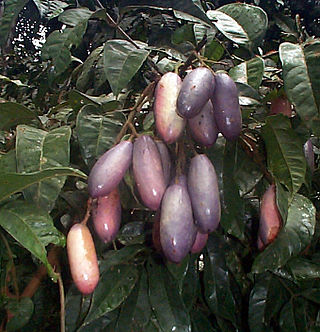
Mauritius, officially the Republic of Mauritius, is an island country in the Indian Ocean, about 2,000 kilometres off the southeastern coast of East Africa, east of Madagascar. It includes the main island, as well as Rodrigues, Agaléga, and St. Brandon. The islands of Mauritius and Rodrigues, along with nearby Réunion, are part of the Mascarene Islands. The main island of Mauritius, where population is concentrated, hosts the capital and largest city, Port Louis. The country spans 2,040 square kilometres (790 sq mi) and has an exclusive economic zone covering 2,300,000 square kilometres.

The Burseraceae are a moderate-sized family of 17-19 genera and about 540 species of woody flowering plants. The actual numbers given in taxonomic sources differ according to taxonomic revision at the time of writing. The Burseraceae are also known as the torchwood family, the frankincense and myrrh family, or simply the incense tree family. The family includes both trees and shrubs; its species are native to tropical regions of Africa, Asia, Australasia, and the Americas.

Dacryodes edulis is a fruit tree in the Burseraceae family native to Africa. Its various regional names include safou, plum (Cameroon), atanga, ube, elumi (Nigeria), African pear, bush pear, African plum, nsafu, bush butter tree, or butterfruit.

Dacryodes excelsa is a tree native to Puerto Rico with a habitat that extends into the Lesser Antilles in the Caribbean region. Its English vernacular names include gommier and candlewood. Its Spanish common name is tabonuco. According to Richards, "it is the most conspicuous large emergent tree" in the Luquillo mountains of Puerto Rico. It is also found in Toro Negro State Forest, in Puerto Rico Cordillera Central. Dacryodes excelsa grows to around 115 feet (35 m), and grows best in soil with a PH of 4.5–5.5.

Cosmopterix is a large genus of moth in the family Cosmopterigidae.

Dacryodes is a genus of about 60 species of trees in the family Burseraceae. The generic name is from the Greek dakruon meaning "tear(drop)", referring to how resin droplets form on the bark surface.

Cosmopterix attenuatella is a moth of the family Cosmopterigidae described by Francis Walker in 1864. It is widely distributed in the tropics and subtropics of both the Old and New World, including the United States, Bermuda, the Cayman Islands, Virgin Islands, Dominica, Jamaica, Puerto Rico, Trinidad and Tobago, Costa Rica, Brazil, Ecuador, Peru, Argentina, the Canary Islands, Madeira, the Galápagos Islands, Cook Islands, Taiwan, Australia, New Zealand, Madagascar, Seychelles, Mauritius and Saint Helena.
Cosmopterix scribaiella is a moth of the family Cosmopterigidae. It is found from most of Europe to Japan.
Dacryodes costata is a tree in the family Burseraceae. The specific epithet costata is from the Latin meaning "ribbed", likely referring to the prominent veins on the leaf underside.
Dacryodes elmeri is a tree in the family Burseraceae. It is named for the American botanist Adolph Elmer.
Dacryodes expansa is a tree in the family Burseraceae. The specific epithet expansa is from the Latin meaning "spread out", referring to the structure of the petals.
Dacryodes incurvata is a tree in the family Burseraceae. The specific epithet incurvata is from the Latin meaning "bending inward", referring to the leaflet margin.
Dacryodes laxa is a tree in the family Burseraceae. The specific epithet laxa is from the Latin meaning "loose", referring to the inflorescence.
Dacryodes longifolia is a tree in the family Burseraceae. The specific epithet longifolia is from the Latin meaning "long leaf".
Dacryodes macrocarpa is a tree in the family Burseraceae. The specific epithet macrocarpa is from the Greek meaning "large fruit".

Dacryodes rostrata is a tree in the family Burseraceae. The specific epithet rostrata is from the Latin meaning "beaked", referring to the narrow-tipped leaves.
Dacryodes rubiginosa is a tree in the family Burseraceae. The specific epithet rubiginosa is from the Latin meaning "rust-coloured", referring to the tomentum.
Dacryodes rugosa is a tree in the family Burseraceae. The specific epithet rugosa is from the Latin meaning "wrinkled", referring to the leaflets.
Dacryodes patentinervia is a tree in the family Burseraceae. It is endemic to Borneo, whereby it is known locally as sabal, sibut or seladah.






